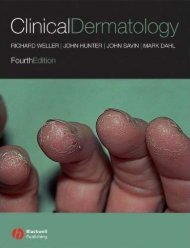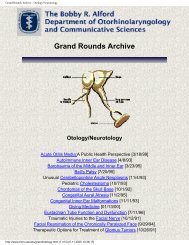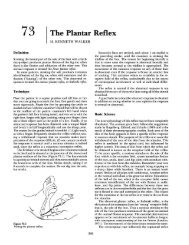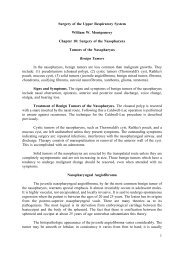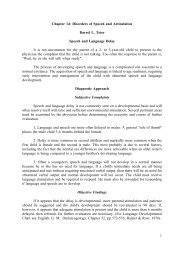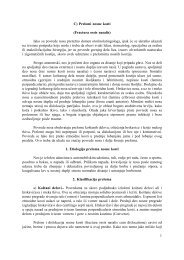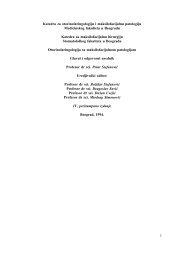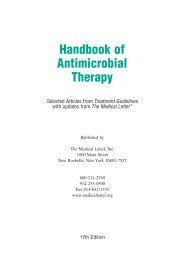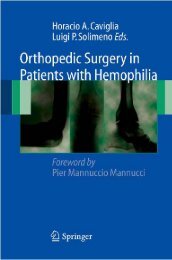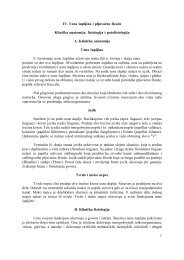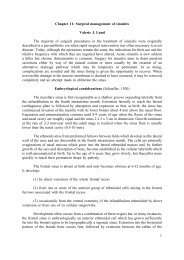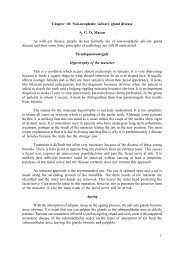1 Chapter 13: Acute suppurative otitis media and acute mastoiditis ...
1 Chapter 13: Acute suppurative otitis media and acute mastoiditis ...
1 Chapter 13: Acute suppurative otitis media and acute mastoiditis ...
You also want an ePaper? Increase the reach of your titles
YUMPU automatically turns print PDFs into web optimized ePapers that Google loves.
Swelling over the mastoid bone may be present, <strong>and</strong> if so either the postauricular<br />
groove is accentuated indicating that the pus is still subperiosteal, or the postauricular groove<br />
is absent, because either the periosteum has given way <strong>and</strong> the pus is subcutaneous, or there<br />
is simple inflammatory oedema over the mastoid.<br />
The presence of fluctuation will distinguish the later abscess formation from the earlier<br />
simple inflammatory oedema.<br />
Protuberance of the pinna can occur either due to simple inflammatory oedema over<br />
the mastoid, or to subcutaneous abscess; subperiosteal abscess with retention of the<br />
postauricular groove does not push the pinna forwards unless the abscess is very large.<br />
Investigations<br />
These are the same as for <strong>acute</strong> <strong>suppurative</strong> <strong>otitis</strong> <strong>media</strong> but the points below should<br />
be remembered.<br />
Microbiology<br />
It is particularly important to obtain an ear swab <strong>and</strong> an early report on the culture <strong>and</strong><br />
sensitivities in case the organisms are not sensitive to the first treatment. Patients, particularly<br />
children, may have a serious illness which in turn may lead to further complications such as<br />
meningitis, <strong>and</strong> valuable time will be lost in treating this potentially lethal condition if culture<br />
is not performed. In more severe cases initial blood cultures are also indicated.<br />
Blood studies<br />
A full blood count should be carried out promptly, <strong>and</strong> repeated during the course of<br />
the disease. A rising leucocyte count invariably indicates pus accumulating <strong>and</strong> unless there<br />
is an obvious cause such as a fluctuant postauricular abscess, signs of intracranial spread must<br />
be looked for.<br />
Audiometry<br />
A pure tone audiogram may show as much as 40-50 dB of conductive hearing loss;<br />
comparison with an audiogram performed during the preceding <strong>acute</strong> <strong>suppurative</strong> <strong>otitis</strong> <strong>media</strong><br />
attack may show that the hearing loss has increased. If the patient is ill, or the mastoid is very<br />
tender, only Rinne <strong>and</strong> Weber tests are called for.<br />
Mastoid X-rays<br />
While seldom required in simple <strong>acute</strong> <strong>suppurative</strong> <strong>otitis</strong> <strong>media</strong>, X-rays will show not<br />
only clouding of cells, which is always present in <strong>acute</strong> <strong>suppurative</strong> <strong>otitis</strong> <strong>media</strong> but also<br />
breaking down of bony air cell walls, indicating progressive disease, or coalescent <strong>mastoiditis</strong>.<br />
The films are also a useful guide, if surgery is required, as to the extent of pneumatization,<br />
which varies greatly (see <strong>Chapter</strong> 2).<br />
17




